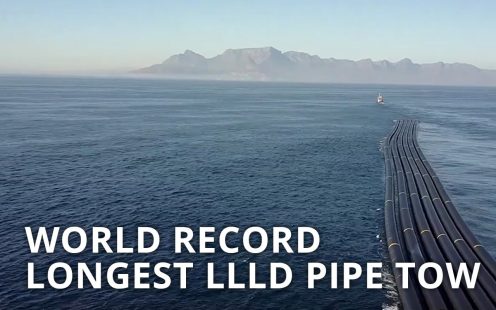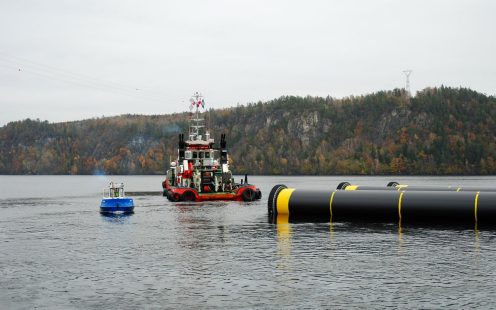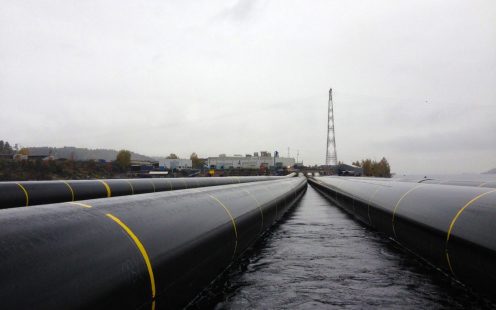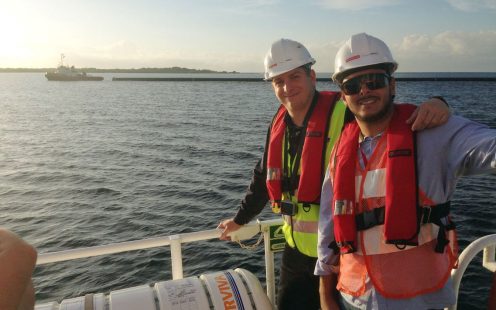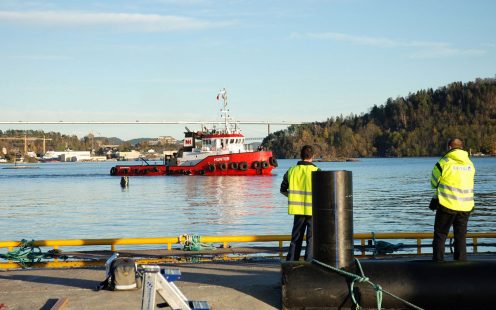Large Diameter HDPE Pipes Travel the Atlantic to be sunk in the Caribbean
Three 350-meter-long, solid wall, so-called long length large diameter Pipes travelled all the way from Norway over the Atlantic Ocean to Punta Catalina power station in the Dominican Republic, where they serve as cooling water lines.
The newly erected plant has a capacity representing 30% of the country's gross energy. Not least because of its strategic importance, client and contractor opted for high-end technology and top-quality solutions.
Project Outline1
With two identical coal-fired units and a coal terminal with a capacity of 80,000 tones, Punta Catalina was built for an output capacity of 752 MW gross.
The project was carried out under the mandate of Corporación Dominicana de Empresas Eléctricas Estatales (The Dominican Corporation of State Electric Companies, or CDEEE) and is located on the south coast of the Dominican Republic. According to the CDEEE, the US$2 billion investment made this project the biggest of its kind in the Caribbean region and imposes social-economic and environmental importance.
Envisioned by the Dominican Republic's government back in 2009, the plan was to develop a new power plant to replace some of the decades-old oil-fueled plants that existed at the time. After feasibility study by the CDEEE, the project was designed, and a groundbreaking ceremony took place in 2013.
An international consortium including Maire Technimont SpA, Odebrecht and Emasa Engineering was responsible for the engineering, procurement and construction of the plant.
Seawater cooling water intake and outfall
Since high-quality and state-of-the-art technology played a major role in this strategically important project, great attention was also attached to the cooling water system.
Seawater is used for a part of the system. It is transported through three solid wall OD2500 mm SDR 26 HDPE pipes, each 350 meters long.
Taking the rough marine environment of the cooling lines into consideration, the international consortium decided to use HDPE solid wall pipe for its sturdiness, resistance and flexibility.
Apart from top material quality, the consortium expected a supplier who would be able to provide technical support and meet the scheduled delivery time. 25 years of expertise in marine applications and transportation as well as technical know-how convinced the decision makers to opt for Pipelife.
Dealing with one single supplier for a complete system was beneficial regarding commercial aspects, consistency in product quality, logistics and warranty.
Pipe Design
The first task was to specify the appropriate pipe size and wall thickness. In close cooperation with engineering and construction company Odebrecht, Pipelife calculated and drew up an optimal system solution comprising pipes, fittings and necessary accessories.
Odebrecht specified the location where the pipes were to be delivered and it was done so to the letter.
Benefits of long length HDPE pipes
At Pipelife's production site in Stathelle, Norway, solid wall HDPE pipes can be produced in one go. Large diameters are extruded to 600 meters length. Smaller diameters for e.g. power and transmission conduits can even be produced to more than a kilometer in length to suit project specifications.
Since the HDPE OD2500 SDR26 pipes for Punta Catalina were specified to a length of 350 meters, the production was never interrupted, and the pipes were cut to the desired lengths without stopping the process.
The lengthy pipe strands present a considerable advantage to client as well as contractor:
- No welding along the pipe
- Less jointing costs
- Faster assembly
- No risk of welded joint failure along the pipe
- Equal strength and robustness along the entire pipe
Fittings Design
In a second step, the necessary fittings were manufactured to the customized design. This included also the diffusor ports which were made of the same material as the rest of the system: HDPE.
The complexity of the fittings and the system's assembly required 3D modeling of the entire pipe system. 3D models and extracted 2D workshop drawings eliminate the risk of design errors and provide a clear guidance throughout all phases of the project.
Marine delivery
Since Pipelife's LLLD pipes are extruded directly into the sea, they are instantly ready to be prepared for transportation by boat to offshore, onshore and near-shore project locations. Once arrived, they are ballasted, submerged and installed.
With more than a quarter of a century of experience in marine deliveries, it was an easy task for Pipelife to choose an appropriately sized tug boat from its well-respected marine towing partner Svendborg Bugser A/S.
Tug boat "Hunter's" special freight was equipped with safety measures such as a GPS tracking system and special radar detection measures to prevent collision on the sea. It set to see on a carefully planned 49-day journey.
Submersion and installation
To submerge the HDPE pipes, which naturally float due to their lower density than water, concrete ballast blocks were produced and mounted on the pipes. The blocks also provide on-bottom stability against waves. In fact, all plastic pipes need to be sufficiently ballasted to secure them on the seabed against waves and currents but also to protect them from damages in case of storms.
Once the pipes were ballasted and towed into position, the pipelines were sunk into the pre-excavated trench by the traditional s-bend method.
Marine contractor ETERMAR - Engenharia e Construção, S.A., experienced in working with long length HDPE pipes, installed the pipes within a day and without any issues.
The client benefited from the flawless execution of high risk and critical marine works as it was completed on time and with highest overall quality.
First output from the power plant2
According to Dominican news, Punta Catalina went into service in February 2019. Due to the positive socio-economic and environmental influence of the plant, Dominican authorities and the CDEEE emphasized how important it was to go from 50 MW test mode output to 200 MW the same month.
About Pipelife's long length HDPE Pipes
Over the past 25 years, we have delivered HDPE Pipes via more than 150 international boat tows in over 140 onshore, offshore and near-shore projects for power, sewage and desalination.
More Information
1) www.bus-ex.com/article/cdeee-punta-catalina-power-central
2) https://dominicantoday.com/dr/economy/2019/02/04/us2-1b-punta-catalina-power-plant-starts-output-in-15-days/
